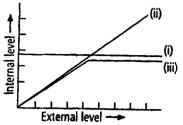Connell's elegant field experiments are related to:
(1) Paramecium
(2) Barnacles
(3) Viruses
(4) Protozoans
Select the false one:
(1) The niche of a population is the set of conditions and resources it uses
(2) Competitive exclusion principle was first described by Gause, for species of Paramecium
(3) If a new predator is introduced to an area with a type of prey that is limited in number the prey species is likely to decrease and possibly become extinct
(4) None of the above
Through resource partitioning:
(1) Two species can compete for the same prey
(2) Slight variation in niche allow closely related species to co-exist in the same habitat
(3) Competitive exclusion results in the success of the superior species
(4) Two species undergo character displacement that allows them to compete
The figure given below is a diagrammatic representation of response of organisms to abiotic factors. What do (i), (ii) and (iii) represent respectively?
|
|
(i) |
(ii) |
(iii) |
|
(1) |
Conformer |
Regulator |
Partial regulator |
|
(2) |
Regulator |
Partial |
Conformer regulator |
|
(3) |
Partial |
Regulator |
Conformer regulator |
|
(4) |
Regulator |
Conformer |
Partial regulator |
When the value of 'r' is significantly low as compared to another species, it is better known by:
(1) Competition exclusion
(2) Interference competition
(3) Resource partition
(4) Competitive release
The four levels of biological organisation to which Ecology is basically concerned are:
A. Macromolecules-tissues-populations-biome
B. Macromolecules-organisms-population-biome
C. Tissues-organs-community-biome
D. Organisms-Populations-Community-Biome
Physiological ecology
- works at organismic level
- Tries to understand the adaptation with respect to survival only
- Tries to understand the adaptation with respect to reproduction only
- None of these
Wide variety of habitats within a biome can be a result of
Regional variation of temperature and precipitation.Life exist in compost pits, permafrost polar regions. Our intestine host only 3-10 microbes. Major biomes of India include desert rainforest and tundra. The important physicochemical components alone chracterise different habitats.
How many of the above statements is/are wrong?
- Three
- Two
- Only one
- All four







